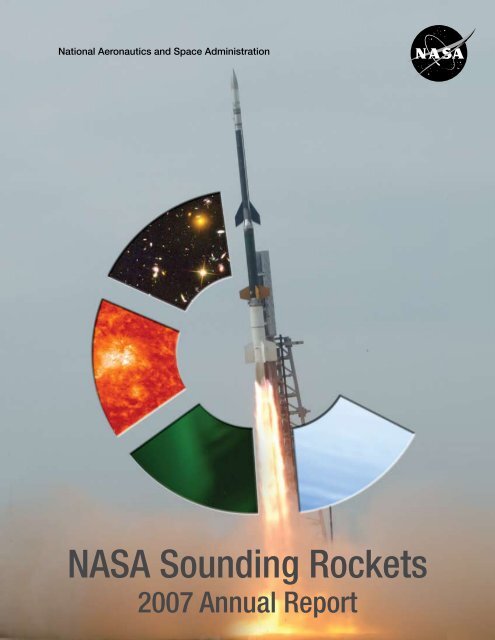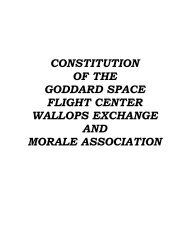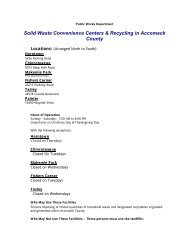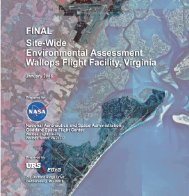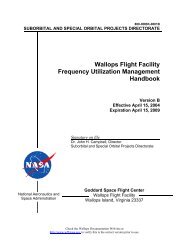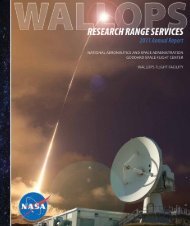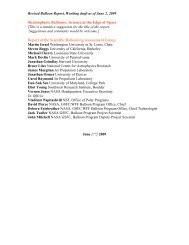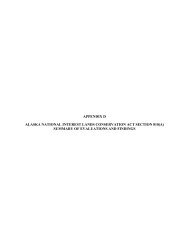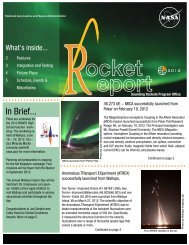Phil Eberspeaker - Wallops Flight Facility - NASA
Phil Eberspeaker - Wallops Flight Facility - NASA
Phil Eberspeaker - Wallops Flight Facility - NASA
Create successful ePaper yourself
Turn your PDF publications into a flip-book with our unique Google optimized e-Paper software.
National Aeronautics and Space Administration<br />
<strong>NASA</strong> Sounding Rockets<br />
2007 Annual Report
Sounding Rocket launch Kwajalein Atoll, 2004 to study mesospheric<br />
instabilities.<br />
Cover: Black Brant XI, 12.064 Hickman, taking off from <strong>Wallops</strong> Island.<br />
Small images represent types of science conducted with sounding rockets;<br />
atmospheric sciences, geophysics, heliophysics and astrophysics.<br />
2 Sounding Rockets Annual Report 2007<br />
The <strong>NASA</strong> Sounding Rockets Program has<br />
completed another active and successful year.<br />
It supported a wide variety of scientific teams<br />
on missions studying plasma, solar and cosmic<br />
physics, and deep space objects. The program also<br />
supported development efforts that will enable<br />
new suborbital, orbital, and planetary missions in<br />
the future. The program’s unique mobile ability<br />
facilitates worldwide launches, anytime, anywhere;<br />
and takes full advantage of specialized scientific<br />
instruments, developed to capture phenomena<br />
which occur at a specific time and place in space.<br />
Many of the 2007 missions featured increased<br />
payload complexity and expanded flight operations.<br />
Future missions being planned and designed for the<br />
coming year promise even more exciting challenges<br />
and significant rewards for the scientific community.<br />
This first annual report-offers some brief insights<br />
into the scientific missions, development efforts,<br />
and the educational and workforce development<br />
projects supported by the <strong>NASA</strong> Sounding Rockets<br />
Program, as well as a forecast of challenges “on<br />
the horizon.”<br />
<strong>Phil</strong> <strong>Eberspeaker</strong><br />
Chief Sounding Rockets Program Office
Sounding Rockets Program – Annual Report 2007<br />
Introduction<br />
Executive Summary<br />
Overview<br />
Achieving <strong>NASA</strong>’s vision and goals<br />
FY 2007 Missions<br />
CyXESS, 36.224<br />
SOHO Cross-Calibration, 36.236<br />
TIMED SEE Calibration, 36.233<br />
ROPA, 40.020<br />
HEX-2, 35,037, 41.061, 41.062, 41.063<br />
JOULE II, 36.234, 21.138, 41.064, 41.065<br />
CHARM, 40.019<br />
MASS, 41.069, 41.070<br />
LIDOS, 36.220<br />
IRVE, 41.055<br />
New Program Capabilities<br />
Celestial ACS<br />
Velocity Vector ACS<br />
Tailored trajectory<br />
Launcher upgrade<br />
S-19 L upgrade<br />
Education & Workforce development<br />
Interns & Co-ops<br />
USERS Program<br />
On the Horizon<br />
Upcoming missions, campaigns & technologies:<br />
Mesospheric Dart<br />
Terrier-improved Malemute<br />
Poker ‘09<br />
Norway campaign (TRICE, SCIFER II)<br />
New <strong>Flight</strong> Termination System<br />
Hypersonics support<br />
Sub-TEC II<br />
Program Statistics<br />
Vehicle Stable<br />
Vehicle Performance<br />
Launch sites<br />
Success History<br />
References<br />
Credits<br />
Terrier-Orion launch from Norway<br />
Rockets ready to launch at Poker Flat, Alaska<br />
Sounding Rockets Annual Report 2007 3
4 Sounding Rockets Annual Report 2007<br />
Single stage Orion ready for launch on <strong>Wallops</strong> Island
Ultra Light Weight mirror post vibration at <strong>Wallops</strong><br />
MASS payload at <strong>Wallops</strong><br />
Payload in spin/balancing facility at <strong>Wallops</strong><br />
Introduction<br />
The Sounding Rockets Program supports <strong>NASA</strong>’s Science<br />
Mission Directorate’s strategic vision and goals for Earth<br />
Science, Heliophysics and Astrophysics. The 20+ suborbital<br />
missions flown annually by the program provide researchers<br />
with unparalleled opportunities to build, test, and fly new<br />
instrument and sensor design concepts while simultaneously<br />
conducting world-class scientific research. Coupled with a<br />
hands-on approach to instrument design, integration and<br />
flight, the short mission life-cycle helps ensure that the next<br />
generation of space scientists receive the training and<br />
experience necessary to move on to <strong>NASA</strong>’s larger, more<br />
complex space science missions. The cost structure and<br />
risk posture under which the program is managed stimulates<br />
innovation and technology maturation and enables rapid<br />
response to scientific events.<br />
With the capability to fly higher than many low Earth<br />
orbiting satellites and the ability to launch on demand,<br />
sounding rockets offer, in many instances, the only means<br />
to study specific scientific phenomena of interest to many<br />
researchers. Unlike instruments onboard most orbital<br />
spacecraft or in ground-based observatories, sounding<br />
rockets can place instruments directly into regions where<br />
and when the science is occurring to enable direct, in-situ<br />
measurements. The mobile nature of the program enables<br />
researchers to conduct missions from strategic vantage<br />
points worldwide.<br />
Sounding Rockets Annual Report 2007 5
Single stage Orion lift-off from <strong>Wallops</strong> Island.<br />
6 Sounding Rockets Annual Report 2007<br />
Executive Summary<br />
Sounding Rockets Support <strong>NASA</strong>’s Strategic<br />
Vision and Goals<br />
<strong>NASA</strong> strategic objectives for Earth Science, Heliophysics, and<br />
Astrophysics are supported by core science missions conducted by the<br />
Sounding Rockets Program. Sounding rockets are also used to support<br />
other strategic objectives of <strong>NASA</strong> such as Aeronautical research and<br />
low-cost test beds for Exploration.<br />
2007 Missions and Accomplishments<br />
Ten science investigations involving 17 vehicles were launched in 2007:<br />
•<br />
•<br />
•<br />
The Poker Flat campaign, January - February 2007, included ten<br />
vehicles with four distinct science objectives.<br />
Several telescope missions were launched from White Sands<br />
Missile Range in New Mexico. The new Celestial Attitude Control<br />
System (CACS) performed exceptionally well during its first<br />
operational flight on the Long-Slit Imaging Dual Order<br />
Spectrograph (LIDOS) mission.<br />
Two payloads were flown from Andoya Rocket Range in Norway<br />
for the MASS mission, which measured properties of<br />
Noctilucent Clouds (NLCs). These launches were coordinated<br />
with the AIM (Aeronomy of Ice in the Mesosphere) satellite and<br />
were part of an international collaborative research campaign<br />
that included other launches.<br />
New Program Capabilities<br />
Several new capabilities were implemented in 2007. As noted above,<br />
CACS was tested and successfully flown on its first operational mission.<br />
A tailored trajectory allowing nearly horizontal flight was successfully<br />
accomplished for only the second time using a new and improved<br />
ACS. Additionally, the S-19 guidance system was upgraded with a new<br />
guidance sensor, and the program’s launch capability was enhanced<br />
with refurbishment of the new Athena Launcher, which was subsequently<br />
installed in Norway.
Education & Workforce Development<br />
Sounding rockets provide opportunities for a wide range of<br />
students from undergraduates to PhD candidates and Post Docs.<br />
Career opportunities range from engineering to scientific research<br />
and development with industry, academia, and government.<br />
New flight opportunities for undergraduate students are under<br />
development.<br />
On The Horizon<br />
New vehicles, several campaigns, new sub-systems, and<br />
hypersonic research support are on the horizon for the Sounding<br />
Rocket program.<br />
Program Statistics<br />
Program statistics presented graphically depict variables such as,<br />
the flight history, vehicle stable and other important quantifiable<br />
aspects of the program.<br />
Sounding Rockets Annual Report 2007 7
<strong>NASA</strong> Strategic Plan Sub-goal 3B:<br />
Understanding the Sun and its effect on<br />
Earth and the solar system.<br />
<strong>NASA</strong>’s Strategic Plan Sub-goal 3C:<br />
Advance scientific knowledge of the origin<br />
and history of the solar system, the potential<br />
for life elsewhere, and the hazards and<br />
resources present as humans explore space.<br />
<strong>NASA</strong>’s Strategic Plan Sub-goal 3D:<br />
Discover the origin, structure, evolution<br />
and destiny of the universe, and search for<br />
Earth like planets.<br />
<strong>NASA</strong>’s Strategic Plan Sub-goal 3E:<br />
Advance knowledge in the fundamental<br />
disciplines of aeronautics, and develop<br />
technologies for safer aircraft and higher<br />
capacity airspace.<br />
Sub-SEM ready to launch,<br />
June 2006<br />
8 Sounding Rockets Annual Report 2007<br />
Sounding Rockets Support <strong>NASA</strong>’s<br />
Strategic Goals<br />
Heliophysics and Earth Sciences<br />
Heliophysics support includes launches to study the fundamental<br />
processes connecting the Sun and Earth. The solar corona is studied with<br />
Extreme UV and X-ray telescope payloads. In-situ measurements of the<br />
ionosphere are conducted with Sounding Rocket instruments flown from<br />
launch sites around the world. Arctic launch sites support the study of<br />
Noctilucent clouds and Polar Mesospheric Summer Echos (PMSE), as well<br />
as studies associated with the Aurora Borealis.<br />
Astrophysics<br />
In the high energy and the ultraviolet and visible part of the spectrum,<br />
Astrophysics utilizes sounding rockets for testing of new instruments and<br />
for unique observational science missions.<br />
Aeronautics<br />
Sounding rockets contribute to <strong>NASA</strong>’s aeronautics program by providing<br />
high-speed test beds for fundamental aeronautical research.<br />
Sounding rockets provide a realistic hypersonic flight test environment for<br />
new materials, shapes and aeronautical concepts.<br />
Planetary Sciences<br />
Studies of planetary and cometary atmospheres have been conducted<br />
with sounding rockets.<br />
Sub-SEM launch,<br />
June 2005<br />
Terrier-ASAS motor test<br />
round, June 2005<br />
Black Brant XI launch,<br />
September 2006
In 2007 the Sounding Rockets Program<br />
Office (SRPO) supported 10 science<br />
research missions, with a total of 17<br />
vehicles, in five different disciplines. A<br />
winter campaign in Poker Flat, Alaska<br />
included ten vehicles to study various<br />
aspects of the aurora. The MASS<br />
mission launches from Norway were<br />
correlated with a pass of the new<br />
Aeronomy of Ice in the Mesosphere<br />
(AIM) satellite.<br />
Light weight mirror pre-integration testing.<br />
science missions - 2007<br />
Sounding Rockets Annual Report 2007 9
10 Sounding Rockets Annual Report 2007<br />
Rocket Observations of Pulsating Aurora (ROPA)<br />
launch, Poker Flat, Alaska 2007.
Cygnus X-ray Emission Spectroscopic Study (CyXESS)<br />
The scientific goal of this sounding rocket was<br />
to obtain x-ray spectral diagnostics of a nearby<br />
extended supernova remnant, the<br />
Cygnus Loop. The Cygnus Loop is<br />
the quintessential middle aged, shell<br />
structured supernova remnant.<br />
Understanding the relationship<br />
that supernovae have with their<br />
environments is crucial when<br />
considering everything from<br />
interfaces between different phases<br />
of the ISM to star formation to<br />
energy and matter feedback in<br />
galaxies and clusters.<br />
The CyXESS instrument addresses<br />
the structure and dynamics of<br />
supernova remnants and the hot<br />
phase of the interstellar medium. The CyXESS<br />
can obtain physical diagnostics of the galactic<br />
halo and possibly even detect emission from the<br />
intergalactic medium.<br />
Mission: 36.224 UH<br />
Discipline: High Energy Astrophysics<br />
Principal Investigator: Dr. Webster Cash<br />
Institution: University of Colorado/LASP<br />
Hubble Space Telescope image of the Cygnus Loop<br />
ROSAT X-ray image of the Cygnus Loop<br />
Sounding Rockets Annual Report 2007 11
Mission: 36.236 US<br />
Discipline: Solar & Heliophysics<br />
Principal Investigator: Dr. Darrell Judge<br />
Institution: University of Southern California<br />
SOHO Eit image of the Sun<br />
Data from 36.236 US<br />
12 Sounding Rockets Annual Report 2007<br />
Rocket Underflights for SOHO Cross-Calibration<br />
& Solar Atmosphere<br />
Rocket underflights for SOHO cross-calibration and solar<br />
atmosphere investigations constitute a multi-year program to<br />
provide the absolute solar flux in the extreme ultraviolet (EUV)<br />
wavelength region. The data obtained will provide calibration data<br />
for the Solar Heliospheric Observer (SOHO) Solar EUV Monitor<br />
(SEM).<br />
This flight presented a unique opportunity to provide<br />
cross-calibration of three EUV instruments and a continuous<br />
calibration record between SOHO-SEM, TIMED-SEE, and the<br />
upcoming SDO-EVE instruments.<br />
The payload was a re-flight of 36.227 US that was successfully<br />
launched and recovered on August 3, 2005, from White Sands<br />
Missile Range, NM.<br />
The science objectives for this mission included:<br />
•<br />
•<br />
•<br />
Measurement, distribution and publication of accurate<br />
absolute solar EUV Irradiance data in support of the SOHO<br />
mission.<br />
Analysis and interpretation of the solar EUV data for the<br />
purpose of improving global solar atmospheric models and to<br />
enhance our understanding of solar variability.<br />
Measurement of the Solar EUV input to Earth’s atmosphere<br />
resulting in increased understanding of the consequences of<br />
the changing flux on atmospheric density and ionization.
The primary objective for this mission was to provide an<br />
underflight calibration for the Solar EUV<br />
Experiment (SEE) aboard the <strong>NASA</strong><br />
Thermosphere-lonosphere-Mesosphere-<br />
Energetics-Dynamics (TIMED)<br />
satellite. The TIMED satellite was<br />
launched in December 2001. The<br />
Sounding Rocket payload 36.192 was<br />
launched in February 2002 as the first<br />
SEE calibration measurement. Two<br />
additional underflight calibrations of the<br />
TIMED satellite were completed in 2003<br />
and 2004 with the launch of 36.205 and<br />
36.217, respectively<br />
Solar extreme ultraviolet (EUV: 0-120 nm) irradiance<br />
impacts the physics of the mesosphere, thermosphere<br />
and ionosphere; because this broad range of radiation<br />
is mostly deposited in the upper atmosphere, it provides<br />
the energy to form and maintain the ionosphere, and to<br />
control the dynamics (winds) and photochemistry of the<br />
thermosphere. The TIMED SEE investigation has been<br />
providing the first daily measurements of the solar EUV<br />
irradiance since the late 1970s. In order to establish the<br />
solar irradiance variation over the long-term, prototype<br />
SEE instruments were developed to measure underflight<br />
calibrations.<br />
TIMED SEE Calibration Experiment<br />
Mission: 36.233 UE<br />
Discipline: Geospace Sciences<br />
Principal Investigator: Dr. Tom Woods<br />
Institution: University of Colorado/LASP<br />
Sounding Rocket payload 36.233<br />
Sounding Rockets Annual Report 2007 13
Mission(s): 40.020 UE<br />
Discipline: Geospace Sciences<br />
Principal Investigator: Dr. Marc Lessard<br />
Institution: University of New Hampshire<br />
Rocket Observations of Pulsating Aurora (ROPA)<br />
ROPA Black Brant XII launch<br />
14 Sounding Rockets Annual Report 2007<br />
The primary objectives of the ROPA mission were:<br />
•<br />
•<br />
To acquire large-scale, topside images of a pulsating auroral region<br />
for comparison to other in-situ data and to optical data from ground<br />
observations;<br />
To investigate current closure associated with pulsating patches.<br />
Two Fly Away Detectors (FADs) were incorporated to obtain information<br />
about pulsating aurora over an extended region. Each FAD included a<br />
science-grade magnetometer, a GPS receiver, and a HEEPS (tophat)<br />
electron detector. The FADs had small rocket motors to achieve<br />
separation velocities of a minimum of~15-20 m/s to provide<br />
simultaneous, multipoint observations with separations in the order of<br />
7-10 km (a significant fraction of typical patch sizes) at apogee. Surplus<br />
Star retro rockets, developed for the Mars Lander program, were used to<br />
propel the sub-payloads<br />
A simulation of the Lessard 40.020 UE mission was conducted at<br />
the Mission Planning Lab (MPL) at <strong>Wallops</strong> <strong>Flight</strong> <strong>Facility</strong>. The MPL,<br />
developed by the Real Time Software Branch, enables visualization of<br />
flight trajectories and payload events such as deployments, Attitude<br />
Control System (ACS) operation, and as with the Lessard mission, FAD<br />
deployments.<br />
40.020 UE Mission Planning Lab simulation
HEX-2<br />
The HEX-2 mission included four rockets to<br />
measure all terms in the atmospheric mass<br />
continuity equation for the first time. All four<br />
payloads were launched in 15-minute launch<br />
window. The HEX-2 mission objectives were<br />
driven by results obtained from its precursor,<br />
HEX-1, launched in 2003, and by the need to<br />
examine the relative importance of various<br />
terms in the continuity equation. Using a<br />
combination of rockets and various<br />
ground-based diagnostics facilities, these<br />
investigations may provide answers to the<br />
physical processes at work in driving<br />
compositional mixing within the lower<br />
thermosphere.<br />
The first rocket, a Black Brant X, delivered a<br />
two-part payload into a nearly horizontal<br />
trajectory with a nominal apogee of 158-km.<br />
This type of Tailored trajectory is a relatively<br />
new capability provided by the SRPO that<br />
enables unique scientific research. The<br />
following three rockets placed identical<br />
two-part payloads into conventional steep<br />
trajectories suitable for releasing six near-<br />
vertical chemical trails between 80- and<br />
180-km altitudes to make near simultaneous<br />
measurements of the neutral winds over a wide<br />
area of the arctic region over central Alaska.<br />
Mission(s): 35.037, 41.061, 41.062 &<br />
41.063 UE<br />
Discipline: Geospace Sciences<br />
Principal Investigator: Dr. John Craven<br />
Institution: University of Alaska<br />
HEX-2 Lift-off from Poker Flat, Alaska<br />
Tailored Trajectory illustration<br />
Sounding Rockets Annual Report 2007 15
Mission(s): 21.138, 36.224, 41.064 &<br />
41.065 UE<br />
Discipline: Geospace Sciences<br />
Principal Investigator: Dr. Miguel Larsen<br />
Institution: Clemson University<br />
Four rockets ready to launch at Poker Flat, Alaska<br />
Payload 36.224 Terrier-Black Brant<br />
16 Sounding Rockets Annual Report 2007<br />
Joule-2<br />
Four rockets (one Black Brant, one Terrier-Black Brant and two Terrier<br />
Orions) were launched to study Joule heating in the ionosphere during an<br />
active aurora above Fairbanks, Alaska in January.<br />
Joule heating is critical to the dynamics,<br />
electrodynamics, and chemistry of the high-latitude<br />
region. Each instrumented rocket was paired with a<br />
chemical release rocket and flown along the same<br />
azimuth to map out the gradients in the neutral winds<br />
and their effect on the local heating rates as a function of<br />
altitude and horizontal distance. The primary<br />
measurements from the instrumented rockets were<br />
vertical profiles and horizontal variations in the electron<br />
densities and the horizontal variations in the electric<br />
fields.<br />
By combining the in situ rocket measurements<br />
with measurements from a high-resolution coherent scatter radar<br />
interferometer, the AMISR incoherent scatter radar, ground-based<br />
photometers, magnetometers, and the SuperDARN radars the scientists<br />
were able to achieve the coverage of scales from a few meters to several<br />
hundred kilometers.<br />
Payload 21.138 Black Brant
Correlation of High Frequencies and Auroral Roar<br />
Measurements (CHARM)<br />
The CHARM rocket experiment was designed<br />
to answer several of the outstanding questions<br />
about the physics of high-frequency waves in<br />
the Earth’s aurora. It was also designed to<br />
enhance our understanding of the dynamical<br />
role of Langmuir and upper hybrid waves, and<br />
the mechanisms and characteristics of resulting<br />
electromagnetic radiation.<br />
By including sophisticated measurements of<br />
correlations between Langmuir waves and<br />
auroral electrons of various energies, this<br />
experiment will directly test theoretical<br />
predictions of wave growth, electron bunching,<br />
and resulting wave evolution. The experiments<br />
included in the CHARM payload were designed<br />
to significantly advance knowledge of high-<br />
frequency emissions in the Earth’s aurora<br />
and, by extension, in analogous beam-plasma<br />
systems elsewhere in the solar system and<br />
beyond.<br />
The CHARM payload engineering drawing.<br />
Mission(s): 40.019 UE<br />
Discipline: Geospace Sciences<br />
Principal Investigator: Dr. James Labelle<br />
Institution: Dartmouth College<br />
CHARM payload on the spin/balance table.<br />
Sounding Rockets Annual Report 2007 17
Mesospheric Aerosol Sampling Spectrometer (MASS)<br />
Mission(s): 41.069 & 41.070 UE<br />
Discipline: Geospace Sciences<br />
Principal Investigator: Dr. Scott Robertson<br />
Institution: University of Colorado/CISP<br />
18 Sounding Rockets Annual Report 2007<br />
The frequency, brightness and spatial coverage of noctilucent clouds<br />
(NLCs) are of increased interest since they were suggested as a “miner’s<br />
canary” for global change. NLC formation involves the presence of<br />
water vapor, nucleation sites and cold temperatures.<br />
Questions remain about the size distribution of precursor<br />
particles, their coupling to electrons and ions, and their<br />
relationships to Polar Mesospheric Summer Echoes<br />
(PMSEs) and anomalously large electric fields.<br />
Launched in 2007, the AIM (Aeronomy of Ice in the<br />
Mesosphere) satellite was designed to observe and<br />
measure the formation and variability of noctilucent<br />
clouds by remote sensing. To complement its<br />
measurements, two rockets were launched from Andoya,<br />
Norway, in the summer NLC season of 2007. The rockets<br />
were instrumented for in situ observations of charged<br />
MASS payload prepared for spin/deployment<br />
and neutral aerosol particles and electric fields. The MASS launches were<br />
MASS payload rendering<br />
coordinated with the German-Norwegian ECOMA (Existence and Charge<br />
State of Meteoric Smoke Particles in the Middle Atmosphere) rockets,<br />
which had similar science objectives.<br />
Noctilucent Clouds imaged by the AIM satellite.
Long-Slit Imaging Dual Order Spectrograph (LIDOS)<br />
The LIDOS instrument was launched from White<br />
Sands, NM with a Black Brant IX Sounding Rocket.<br />
LIDOS investigated the relationship between the<br />
far-ultraviolet scattering and extinction properties<br />
of dust and molecular hydrogen (H2). This flight<br />
observed the Trifid Nebula (M 20), to measure the<br />
spectra of its exciting stars and the surrounding gas<br />
Hubble Space Telescope image of the Trifid Nebula<br />
and dust, and to account<br />
for the total luminous output<br />
of the nebula in the far-<br />
ultraviolet.<br />
The LIDOS mission<br />
incorporated the new<br />
Celestial Attitude Control<br />
System (CACS). CACS<br />
provides sub-arc-second<br />
pointing capability allowing<br />
precise alignment with the<br />
object under study. Additionally, observation times<br />
are increased and the command uplink, for pitch, yaw<br />
and roll control, allows for real-time adjustments of<br />
the payload pointing.<br />
Mission(s): 36.220 UG<br />
Discipline: UV/Optical Astrophysics<br />
Principal Investigator: Dr. Stephen McCandliss<br />
Institution: Johns Hopkins University<br />
CACS airbering test.<br />
Sounding Rockets Annual Report 2007 19
Mission(s): 41.055 NP<br />
Discipline: Special Project<br />
Principal Investigator: Player<br />
Institution: <strong>NASA</strong> Langley Research Center<br />
IRVE fully inflated<br />
IRVE before inflation<br />
20 Sounding Rockets Annual Report 2007<br />
Inflatable Reentry Vehicle Experiment (IRVE)<br />
IRVE was the first in a series of flight tests designed to develop and<br />
validate an inflatable decelerator ballute concept. The conceptual testing<br />
of the inflatable decelerator will be conducted in a stair-step manner with<br />
future test building on the previous test.<br />
IRVE is intended to demonstrate inflation and survivability at a realistic<br />
dynamic pressure and ballistic coefficient. Follow on flights will<br />
demonstrate survivability and performance at relevant heating and<br />
IRVE stowed<br />
relevant vehicle size.<br />
The mission objectives for the IRVE series are to:<br />
•<br />
•<br />
•<br />
Execute flight-tests that demonstrate inflation<br />
and survivability at a relevant dynamic<br />
pressure.<br />
Assess the performance of the vehicle from a<br />
thermal and structural dynamics perspective.<br />
Validate the analysis and design techniques<br />
used in the development of the Reentry<br />
Vehicle.
Launch capability was enhanced<br />
with the installation of the<br />
Athena launcher in Norway. New<br />
and upgraded sub-systems and<br />
new capabilities placed in service<br />
include: Celestial Attitude<br />
Control System (CACS), S19L<br />
boost guidance system and an<br />
ability to fly more accurate<br />
tailored trajectories.<br />
A four stage Black Brant XII lifts off from the newly<br />
installed Athena launcher in Norway.<br />
new capabilities<br />
Sounding Rockets Annual Report 2007 21
The Celestial Attitude Control System airbearing test.<br />
22 Sounding Rockets Annual Report 2007<br />
New Program Capabilities<br />
Celestial Attitude Control System (CACS)<br />
The new Celestial Attitude Control System was flight demonstrated to<br />
achieve better than 0.2 arcsec, 1 sigma and 0.5 arcsec Full Width at Half<br />
Maximum (FWHM) pointing precision for<br />
each axis. Key components of this new<br />
ACS include a roll stabilized fiber optic<br />
gyro; a precision fiber optic gyro; a cold gas<br />
linear thrust module; a pitch, yaw and roll<br />
uplink command system; and a 3 axis star<br />
tracker.<br />
In addition to providing gyro drift<br />
compensation, the star tracker provides<br />
celestial reference through its Lost in Space<br />
(LIS) solution. The maneuver algorithm<br />
employed rotates the pointing axis of the<br />
payload along a great circle to science<br />
targets. The successful flight test of this<br />
system, developed in house, enabled<br />
the payload science team to study the<br />
Trifid Nebula in the far-Ultra Violet (UV).<br />
Time to target was much shorter with this<br />
new system and increased science observation time. A re-fly mission<br />
is scheduled to study the Orion Nebula also in the far-UV. Additionally,<br />
flights to study cosmic background radiation and to test a nulling<br />
interferometer designed to detect exo-planets, are planned for the future.<br />
GPS Velocity Vector Attitude Control System<br />
The NSROC Inertial Attitude Control System (NIACS) was modified to<br />
accept GPS inputs and perform computations and control solutions to<br />
allow the payload to remain aligned with the velocity vector throughout<br />
the entire flight. This system also permits attitude corrections during<br />
payload events such as sub-payload and main boom deployments, and<br />
main payload attitude control after boom deploy.
TAILORED SOUNDING ROCKET TRAJECTORY<br />
Raw payload position and velocity are provided by the GPS. The<br />
computer uses the GPS information to determine a refined velocity<br />
vector for the target. The computer also determines the attitude solution<br />
and, based on the mission plan, determines thruster firings to achieve<br />
the desired payload attitude. The GPS-based Velocity Vector Input to<br />
NIACS has been flown five times to date; this included one development<br />
validation flight and four science missions. This system was critical to the<br />
MASS missions launched from Norway in August 2007.<br />
Tailored Trajectory<br />
A horizontal trajectory, using the more accurate NIACS, was flown on the<br />
Craven 35.037 (Black Brant X) Sounding Rocket mission. This was the first<br />
in a series of four launches to measure all components of the atmospheric<br />
continuity equation.<br />
ACS Realignment<br />
Thrust Vector<br />
Realigned<br />
Post-Boost Coast<br />
Velocity and Thrust<br />
Vector Co-Aligned<br />
Motor Burn<br />
Thrust Vector Delta-V<br />
Produces New Resultant<br />
Velocity Vector<br />
Motor Separation<br />
ACS Realigns P/L to<br />
Velocity Vector or<br />
Other Reference<br />
350<br />
Ballistic Trajectory<br />
300<br />
Tailored Trajectory<br />
250<br />
200<br />
150<br />
100<br />
50<br />
0<br />
0 100 200 300 400 500<br />
KM DOWNRANGE<br />
Resultant Velocity Vector Thrust Velocity Vector Gravity<br />
Illustration of tailored trajectory flight.<br />
For the Craven mission the mother-daughter payload and the third stage<br />
Nihka were reoriented prior to Nihka ignition. Nihka ignition occurred at<br />
around 110-km altitude. This provided additional horizontal velocity<br />
needed to achieve the near-horizontal tailored trajectory for the science<br />
KM ALTITUDE<br />
Sounding Rockets Annual Report 2007 23
Athena launcher<br />
installation in progress<br />
at Andoya Rocket<br />
Range, Norway (above).<br />
Launcher leaving <strong>Wallops</strong><br />
Island (right).<br />
Black Brant X launch from White Sands Missile Range, NM<br />
with an S19 boost guidance system.<br />
24 Sounding Rockets Annual Report 2007<br />
portion of the flight. At approximately 160-km altitude, a 200-km TMA<br />
chemical trail was deployed nearly horizontally across a region of active<br />
aurora.<br />
This new and improved, near horizontal trajectory option expands the<br />
envelope for science investigations using sounding rockets and allows<br />
longer flight times in a specific science region of the atmosphere.<br />
New Launch Capability in Norway<br />
To enhance launch capability and to support <strong>NASA</strong>’s<br />
largest sounding rocket vehicles, the Athena launcher<br />
was refurbished at <strong>Wallops</strong> then shipped, reassembled<br />
and installed at Andoya Rocket Range. The launcher<br />
was used for the MASS mission in August 2007, and<br />
will be crucial in supporting the TRICE missions. The<br />
Trice missions will require near simultaneous launch of<br />
two Black Brant XII vehicles in December 2007.<br />
Upgraded S-19L Guidance System<br />
The S19 boost guidance system significantly reduces impact<br />
dispersion and enables flights from locations with limited impact<br />
areas, such as White Sands Missile Range in New Mexico. Over<br />
200 sounding rockets have flown with this system.<br />
The S19L is the fourth generation guidance system and includes<br />
significant gyro and processor upgrades. The strapped down<br />
LN 200 Fiber Optic Gyros used in the S19L are far more accurate and<br />
reliable than their predecessors. The gyros remain active throughout flight,<br />
providing additional attitude information for post flight analysis of payload<br />
position during mission and re-entry.
Sounding rockets provide numerous<br />
opportunities for students,<br />
ranging from new undergraduate<br />
flight opportunities to doctorate level<br />
research. Scientists with sounding<br />
rocket experience are successful<br />
competitors for satellite flight<br />
opportunities.<br />
Michael Shimogawa, graduate student at<br />
University of Washington preparing one of<br />
the MASS payloads for spin/deployment<br />
tests at <strong>Wallops</strong>.<br />
education & workforce<br />
Sounding Rockets Annual Report 2007 25
Scott Knappmiller, graduate student at University<br />
of Colorado, working with Dr. Zoltan Sternovsky on<br />
one of the MASS payload.<br />
NSROC engineering intern Nate Empson working<br />
on the LeClair payload.<br />
Mike Larson, graduate student University of Iowa<br />
and Chris Colpitts graduate student Dartmouth<br />
College working on one of the TRICE payloads.<br />
26 Sounding Rockets Annual Report 2007<br />
Education & Workforce development<br />
For decades, the Sounding Rockets Program has provided hands-on<br />
training opportunities for scientists, graduate and undergraduate students,<br />
engineers, and technicians. These early experiences in developing sensors,<br />
instruments, and other subsystems for spaceflight are invaluable to gaining an<br />
understanding of what it takes to fly instruments in the unforgiving environment<br />
of space. The short mission life cycle coupled with the design-build-fly nature of<br />
the program ensures exposure to all facets of spaceflight.<br />
Professors, Post Docs, and PhD candidates from within <strong>NASA</strong>, other<br />
government organizations, and academic institutions are all currently working on<br />
instruments which will be flown in the near future on a Sounding Rocket mission.<br />
The knowledge gained through this direct hands-on experience helps to ensure<br />
that a steady pipeline of scientists, researchers and engineers are prepared to<br />
take on the next challenges of <strong>NASA</strong>’s scientific research programs. Sounding<br />
Rocket Principal Investigators are frequently selected as instrument PIs on<br />
satellite programs such as the Radiation Burst Storm Probes (RBSP), currently<br />
under development. The two instrument PIs on this project began their research<br />
on Sounding Rocket missions.<br />
The <strong>NASA</strong> Sounding Rocket Operations Contract (NSROC) has developed a<br />
successful intern and co-op program. To date, 86 undergraduate and graduate<br />
students from ten different universities have participated. Over 10% of the<br />
students have been hired by NSROC as full time employees; 18 have obtained<br />
or are currently pursuing advanced engineering degrees and several others are<br />
working in related industries.<br />
University Student Experiment Ride Share<br />
(USERS)<br />
Geared toward undergraduate students, the USERS program is currently in the<br />
development stage. A pilot program has been initiated to evaluate the viability<br />
of this program as a cost-effective means of increasing exposure to sounding<br />
rocket technology across academia. USERS will allow up to four universities to<br />
build, test, and fly experiments on a single mission. A university with prior launch<br />
experience will be competitively selected through a proposal submission and<br />
review process to serve as USERS Integrator. The Integrator will be responsible<br />
for coordination, payload design, and initial integration of all payload<br />
experiments. One Terrier-Orion flight per year from <strong>Wallops</strong> Island is planned for<br />
this project.
Two campaigns, Norway 2008 and<br />
Poker Flat 2009, are in process.<br />
New vehicle systems under development<br />
include a Mesospheric Dart<br />
and a two-stage Terrier-Improved<br />
Malemute. Additionally, hypersonics<br />
support, technology payloads, and<br />
new upgraded support systems are<br />
on the horizon.<br />
on the horizon<br />
Sounding Rockets Annual Report 2007 27
TRICE payload in the magnetic calibration facility at <strong>Wallops</strong>.<br />
SCIFER-2 in the spin/deployment facility at <strong>Wallops</strong>.<br />
28 Sounding Rockets Annual Report 2007<br />
On the Horizon<br />
Campaigns: Norway FY 08<br />
Three Black Brant XII vehicles will be launched from Andoya Rocket<br />
Range in Norway during the 2007 - 2008 auroral season. The new<br />
Athena launcher will enable the Twin Rockets Investigating the Cusp<br />
Electrodynamics (TRICE) mission to launch two Black Brant XII rockets in<br />
very close sequence. SCIFER-2 which is also a Black Brant XII will launch<br />
after the TRICE mission is completed.<br />
The TRICE mission will be initiated with the launch of a Black Brant<br />
XIII (TRICE-HIGH), with a predicted apogee greater than 1150 km.<br />
Approximately two minutes later another Black Brant XII (TRICE-LOW),<br />
will be launched at lower elevation so that it achieves an apogee of 400<br />
km at approximately the same time TRICE-HIGH reaches apogee. TRICE<br />
will study the ionosphere signatures of reconnection in order to better<br />
understand the temporal/spatial nature of reconnection. Reconnection<br />
research is very active, but the ability to make high resolution in-situ<br />
measurements in near-Earth space plasmas, using sounding rockets,<br />
offers unique insight into the process. The signatures of magnetic<br />
reconnection are often observed in satellite data, but these data are<br />
limited in interpretation because of the spatial-temporal ambiguity of<br />
single spacecraft measurements. The Principal Investigator for TRICE is<br />
Dr. Craig Kletzing, University of Iowa.<br />
Sounding of the Cusp Ion Fountain Energization Region-2 (SCIFER-2) is<br />
scheduled for launch from Andoya Rocket Range in Norway following the<br />
TRICE launches. The SCIFER-2 mission will study ion outflows between<br />
200 and 1400 km in the polar cusp. In addition to the rocket, two EISCAT<br />
radars (Svalbard and Tromsø) will be used to monitor ion flows under<br />
the rocket apogee for comparison with the sounding rocket data and to<br />
determine the launch conditions. The Principal Investigator for SCIFER-2<br />
is Dr. Paul Kintner, Cornell University.
Beamformer, developed by JEM Engineering, being prepared<br />
for testing at <strong>Wallops</strong>.<br />
Campaigns: Poker Flat FY 09<br />
Eight missions have been selected for flight from Poker Flat, Alaska during<br />
the auroral season January - March 2009. Participating organizations<br />
include University of Iowa, Dartmouth College, Clemson University and<br />
University of Alaska. The scientific investigations will study several facets<br />
of Auroral electrodynamics. Additionally a student outreach mission will<br />
be launched in support of the University of Alaska project.<br />
Sub-TEC II<br />
The Sub-TEC technology demonstration initiative serves to improve<br />
technical capabilities of the Sounding Rocket Program and other users<br />
by providing a standardized carrier platform to flight demonstrate new<br />
technologies. Sub-TEC payloads provide opportunities for multiple<br />
experiments and organizations to share the cost of a flight test mission.<br />
The Sub-TEC II 2008 flight includes a Phased Array Antenna/Beamformer,<br />
developed by JEM Engineering under <strong>NASA</strong>’s Small Business Innovative<br />
Research (SBIR) Program. Other Sub-TEC II components and instruments<br />
provided by NSROC include a Miniature PCM Encoder and Pyro Control<br />
System, Sun Sensors, Horizon Crossing Indicator, micro/miniature real<br />
time attitude solution (RTAS) unit, and Next Generation GPS<br />
New Vehicle Systems<br />
A Mesospheric Dart, based on the Multiple Launch Rocket System (MLRS)<br />
M26 motor, is under development. The M26 is a military surplus motor and<br />
the Dart is designed and manufactured at <strong>Wallops</strong> <strong>Flight</strong> <strong>Facility</strong>.<br />
Predicted flight performance indicates altitudes around 95 km with a 50<br />
lb dart are possible. Several test flights are scheduled to confirm the<br />
performance envelope of the system, as well as flight qualify sub-systems<br />
and payload electronics.<br />
This new capability is a cost effective solution to many science disciplines<br />
requiring in-situ measurements at altitudes up to 95 km. Instruments<br />
deemed feasible for launch with the Mesospheric Dart include:<br />
•<br />
•<br />
•<br />
•<br />
•<br />
Chemical Release payloads<br />
Electric Field Booms,<br />
Langmuir Probes<br />
Photometers<br />
Radiometers<br />
Sounding Rockets Annual Report 2007 29
Altitude - km<br />
100<br />
80<br />
60<br />
40<br />
20<br />
Experiment Volume: 34 in³<br />
Experiment diameter: 3.5 in<br />
Experiment Weight: 7 lbs<br />
Avionics suite:<br />
PCM system<br />
32 channel TM<br />
3-axis Magnetometer<br />
3-axis Accelerometer<br />
14 V , 5 Amp NiMH<br />
battery pack<br />
Mesospheric Dart<br />
Estimated preliminary performance<br />
(payload 50 lbs)<br />
Length: 58 inches<br />
Total weight: 51 lbs<br />
Diameter: 4 inches<br />
0<br />
0 50100 150<br />
Time - sec<br />
200 250 300<br />
30 Sounding Rockets Annual Report 2007<br />
MLRS M26 Motor - 100 in NEP Dart - 58 in NEP
Terrier-Malemute in Kwajalein 2004.<br />
HyBolt on the vibration table at <strong>Wallops</strong>.<br />
SCRAMP - Typical geometry<br />
•<br />
•<br />
•<br />
Robin Spheres<br />
Meteor Dust Collection<br />
Aerosol & Gas Sampling<br />
A Terrier-Improved Malemute motor stack is being evaluated for future use<br />
based on the recent availability to the SRPO of a new surplus upper stage<br />
motor. This vehicle shows promise as an enhancement to the existing<br />
fleet with a performance close to the single stage Black Brant V. Payloads<br />
between 600 and 1200 pounds can be launched to altitudes of 150 to 300<br />
km. This vehicle, which features reduced wind sensitivity and smaller impact<br />
dispersions, is well suited for hypersonic research, re-entry test flights and<br />
other missions with high Mach number requirements.<br />
<strong>Flight</strong> Termination System<br />
Black Brant IX flights from White Sands Missile Range and shaped<br />
mission trajectories require a <strong>Flight</strong> Termination System (FTS). A new<br />
next generation FTS, compliant with the redundancy requirements of the<br />
Range Commanders Council, Range Safety Group, is under development.<br />
Preliminary component selection has been completed and the components<br />
will be evaluated based on environmental data collected for Black Brant<br />
MK1 motor.<br />
Hypersonics Support<br />
Several hypersonics projects are supported by SRPO and NSROC.<br />
Environmental testing and engineering support is being provided for the<br />
HyBolt experiment team. HyBolt will be launched onboard the ATK ALV-X1<br />
vehicle. The HyBolt experiment will measure boundary layer transition<br />
location, fluctuation intensity, disturbance frequencies, and propagation<br />
speed and direction. A roughness experiment will provide confirmation<br />
of the relative effectiveness of several representative tip configurations.<br />
Included in the first ATK ALV-X1 launch is an experiment from <strong>NASA</strong> Ames.<br />
This non-traditional entry probe configuration is introduced as the SCRAMP,<br />
or Slotted Compression RAMP probe.<br />
Another Inflatable Re-entry Vehicle Experiment (IRVE) flight is anticipated<br />
in the future. The IRVE ballute experiments provide valuable data for future<br />
planetary entry missions requiring high speed re-entry. Sounding rockets<br />
provide a functional test bed for these types of experiments.<br />
Sounding Rockets Annual Report 2007 31
32 Sounding Rockets Annual Report 2007<br />
program statistics
Ten vehicles ranging from a single stage Orion to a four stage Black Brant XII make up the core of the Sounding Rockets Program.<br />
New vehicles, the MLRS-Dart and Terrier-Improved Malemute will be added in the near future. Above: relative scale of the currently<br />
available vehicles. Below: Vehicle performance altitude vs. payload weight.<br />
Altitude Apogee (km)<br />
1800<br />
1600<br />
1400<br />
1200<br />
1000<br />
800<br />
600<br />
400<br />
200<br />
0<br />
BB X<br />
Mod 1<br />
BB X<br />
Terrier-<br />
Malemute<br />
Nike-Orion<br />
Black Brant<br />
V<br />
Orion<br />
Sounding Rocket Vehicle Performance<br />
Nike-Brant<br />
Terrier-Orion<br />
0 200 400 600 800 1000 1200 1400 1600<br />
Payload Weight (pounds)<br />
BB XII<br />
BB XI<br />
Terrier-Brant Mod 2<br />
Terrier-Brant<br />
Sounding Rockets Annual Report 2007 33
1<br />
Poker Flat, Alaska<br />
2<br />
34 Sounding Rockets Annual Report 2007<br />
3<br />
4<br />
5<br />
8<br />
7<br />
9<br />
6<br />
Esrange, Sweden<br />
Andoya, Norway Woomera, Australia<br />
13<br />
10 11 12<br />
Kwajalein, Marshall Is.<br />
Past and present world wide launch sites used by the Sounding Rockets Program<br />
to conduct scientific research:<br />
1. Kwajalein Atoll, Marshall Islands<br />
2. Barking Sands, HI<br />
3. Poker Flat, AK<br />
4. White Sands, NM<br />
5. Punta Lobos, Peru *<br />
6. Alcantara, Brazil *<br />
7. Camp Tortuguero, Puerto Rico *<br />
* In-active launch sites<br />
8. <strong>Wallops</strong> Island, VA<br />
9. Fort Churchill, Canada *<br />
10. Greenland (Thule & Sondre Stromfjord) *<br />
11. Andoya, Norway<br />
12. Esrange, Sweden<br />
13. Svalbard, Norway<br />
14. Woomera, Australia<br />
14<br />
<strong>Wallops</strong> Island, VA
Number of launches<br />
Number of Launches<br />
35<br />
30<br />
25<br />
20<br />
15<br />
10<br />
5<br />
0<br />
120<br />
100<br />
80<br />
60<br />
40<br />
20<br />
0<br />
29<br />
28<br />
28<br />
Geospace Sciences<br />
21<br />
21<br />
21<br />
23<br />
23<br />
22<br />
16<br />
14<br />
13<br />
Sounding Rocket launches<br />
FY 1997 - 2007<br />
Total number of launches: 240<br />
12<br />
12<br />
12<br />
27<br />
27<br />
27<br />
27<br />
26<br />
24<br />
26<br />
25<br />
20<br />
19<br />
17<br />
16<br />
22<br />
22<br />
22<br />
97 98 99 00 01 02 03 04 05 06 07<br />
102<br />
Special Projects<br />
Fiscal Year<br />
Launches by Discipline, FY 1997-2007<br />
Total launches: 240<br />
24 23 23 22<br />
UV/Optical Astrophysics<br />
Reimbursable<br />
Solar and Heliospheric Sciences<br />
Test and Support<br />
Discipline<br />
17<br />
Student Outreach<br />
13<br />
Solar System Exploration<br />
7<br />
Microgravity Research<br />
18<br />
18<br />
15<br />
5 4<br />
High Energy Astrophysics<br />
Launches<br />
Vehicle Success<br />
Mission Success<br />
Sounding Rockets Annual Report 2007 35
References<br />
Dr. Cash, Sounding Rocket Design Review Data Package 36.224<br />
Dr. Judge, Sounding Rocket Design Review Data Package 36.236<br />
Dr. Woods, Sounding Rocket Design Review Data Package 36.233<br />
Dr. Larsen, Sounding Rocket Design Review Data Package 21.138, 36.224, 41.064, 41.065<br />
Dr. Craven, Sounding Rocket Design Review Data Package 35.037, 41.061, 41.062, 41.063<br />
Dr. Lessard, Sounding Rocket Design Review Data Package 40.020<br />
Dr. Labelle, Sounding Rocket Design Review Data Package 40.019<br />
Dr. Robertson, Sounding Rocket Design Review Data Package 41.069, 41.070<br />
Dr. McCandliss, Sounding Rocket Design Review Data Package, 36.220<br />
Mr. Player, Sounding Rocket Design Review Data Package 41.055<br />
Shoemaker et al., Sub-Arcsecond Attitude Control for Sounding Rocket Payloads, Preliminary submission for AIAA,<br />
Kletzing et al., Sounding Rocket Design Review Data package, May 2007<br />
36 Sounding Rockets Annual Report 2007
Credits:<br />
Cover: Rocket liftoff photo by <strong>Wallops</strong> Photolab. Report cover, layout and design by Berit Bland/810/BBCO.<br />
Page 2: Kwajalein rocket launch, nowhereatoll.com (http://www.nowhereatoll.com)<br />
Page 3: Launch from Norway, Scott Hesh/NSROC, Rockets on the pad in Alaska, Scott Hesh/NSROC<br />
Page 4: Orion on the launch pad, Lee Wingfield/<strong>Wallops</strong> photolab<br />
Page 5: All photos, Berit Bland/810/BBCO<br />
Page 6: Orion lift-off, <strong>Wallops</strong> Photolab<br />
Page 8: All photos, <strong>Wallops</strong> Photolab<br />
Page 9: Photo by Berit Bland/810/BBCO<br />
Page 10: ROPA Launch photo by Todd Valentic<br />
Page 11: Cygnus loop, <strong>NASA</strong> HST& Jeff Hester/Arizona State University and ROSAT image of Cygnus loop, Levenson et al<br />
Page 12: SOHO image of the Sun, Payload data graph: Dr. Judge, SOHO space craft image, Alex Lutkus<br />
Page 13: Payload drawing, Dr. Woods, TIMED satellite rendering, <strong>NASA</strong>/Johns Hopkins University Applied Physics Laboratory (JHU/APL)<br />
Page 14: ROPA launch photo, Todd Valentic, MPL screen shot by Code 589 <strong>Wallops</strong><br />
Page 15: HEX-2 liftoff, Tailored Trajectory graphic designed by Jessica Ransone<br />
Page 16: Rockets ready to launch in Alaska, Scott Hesh/NSROC, Payload renderings, NSROC Mechanical Section<br />
Page 17: Payload on spin/balance table, Berit Bland/810/BBCO, Payload rendering, Shane Thompson/NSROC<br />
Page 18: Photo pf spin/deploy, Berit Bland/810/BBCO, Noctilucent Cloud by AIM satellite, AIM satellite graphic, Emily Hill Designs/<br />
Hampton University, MASS rocket payload drawing, Shane Thompson/NSROC<br />
Page 19: Trifid Nebula, <strong>NASA</strong> Hubble & Jeff Hester/Arizona State University, CACS airbering test, Berit Bland/810/BBCO<br />
Page 20: All photos by <strong>NASA</strong> Langley IRVE team<br />
Page 21: Rocket launch from Andoya, Trond Abrahamsen<br />
Page 22: Airbearing test, Berit Bland/810/BBCO<br />
Page 23: Tailored Trajectory graphic design by Jessica Ransone<br />
Page 24: Andoya launcher installation, <strong>NASA</strong>, Athena launcher leaving <strong>Wallops</strong>, Jan Jackson/NSROC, Rocket Launch,<br />
Visual Information Branch, White Sands Missile Range, S-19, SAAB<br />
Page 25: Photo by Berit Bland/810/BBCO<br />
Page 26: Photos by Berit Bland/810/BBCO<br />
Page 27 Image Science and Analysis Laboratory <strong>NASA</strong> Johnson Space Center “The Gateway of Astronaut Photography of Earth”.<br />
Page 28: Photos by Berit Bland/810/BBCO<br />
Page 29: Photos by Berit Bland/810/BBCO<br />
Page 30: Mesquito renderings by Andy Owens and Joshua Yaccobucci, NSROC<br />
Page 31: Terrier-Malemute in Kwaj, Bruce Scott/NSROC, Hy-Bolt, Berit Bland/810/BBCO, SCRAMP, Mark Murbach/<strong>NASA</strong> Ames<br />
Page 34: Poker Flat, Scott Hesh/NSROC, Kwaj, Bruce Scott/NSROC, Esrange launch, Esrange/SSC, Andoya launch/Scott Hesh<br />
Sounding Rockets Annual Report 2007 37
.......
National Aeronautics and Space Administration<br />
Goddard Space <strong>Flight</strong> Center<br />
<strong>Wallops</strong> <strong>Flight</strong> <strong>Facility</strong><br />
34200 Fulton Street<br />
<strong>Wallops</strong> Island, VA 23337<br />
www.nasa.gov/centers/wallops<br />
www.nasa.gov


